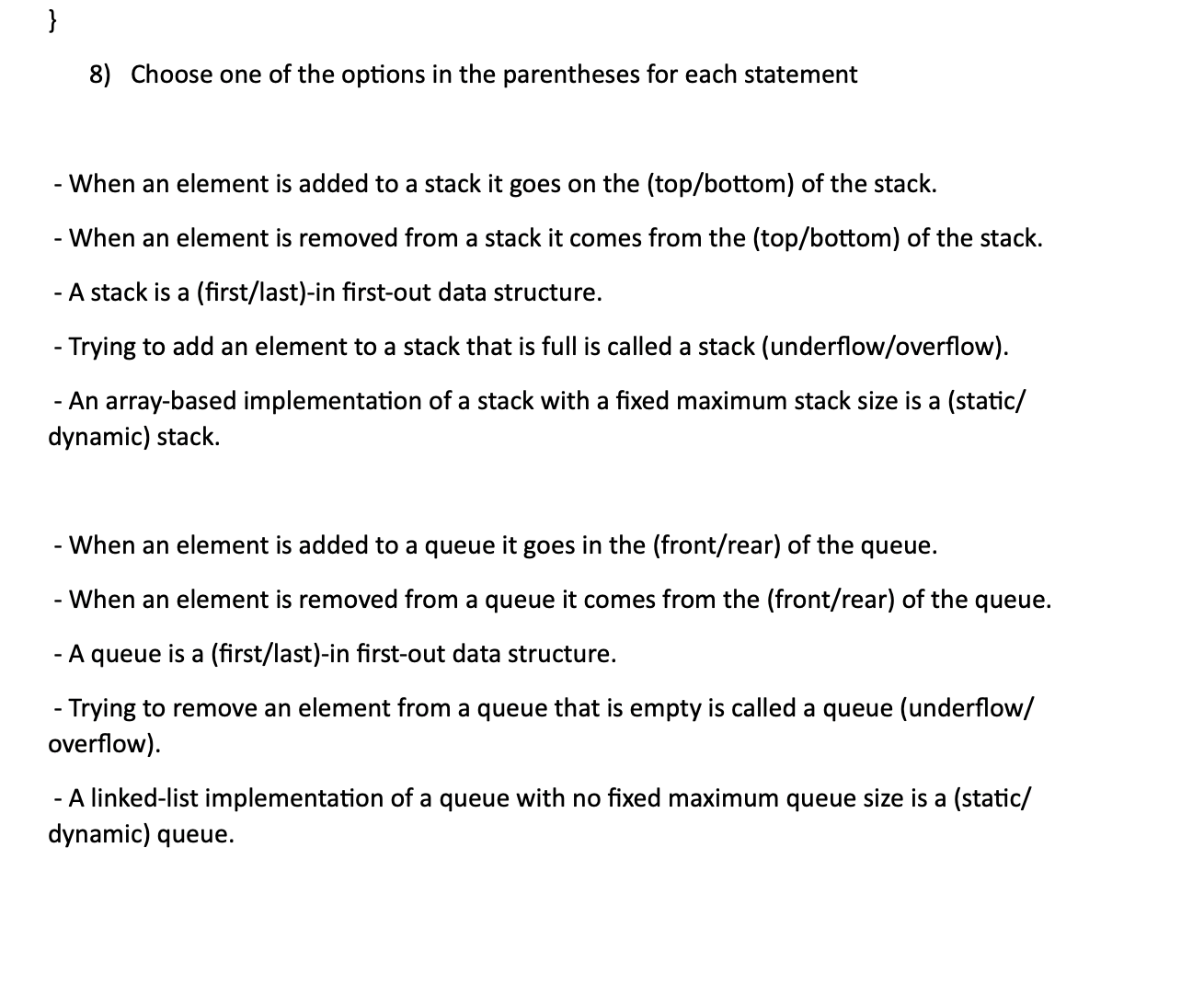8) Choose one of the options in the parentheses for each statement - When an element is added to a stack it goes on the (top/bottom) of the stack. - When an element is removed from a stack it comes from the (top/bottom) of the stack. - A stack is a (first/last)-in first-out data structure. - Trying to add an element to a stack that is full is called a stack (underflow/overflow). - An array-based implementation of a stack with a fixed maximum stack size is a (static/ dynamic) stack. - When an element is added to a queue it goes in the (front/rear) of the queue. - When an element is removed from a queue it comes from the (front/rear) of the queue - A queue is a (first/last)-in first-out data structure. - Trying to remove an element from a queue that is empty is called a queue (underflow/ overflow). - A linked-list implementation of a queue with no fixed maximum queue size is a (static/ dynamic) queue.
8) Choose one of the options in the parentheses for each statement - When an element is added to a stack it goes on the (top/bottom) of the stack. - When an element is removed from a stack it comes from the (top/bottom) of the stack. - A stack is a (first/last)-in first-out data structure. - Trying to add an element to a stack that is full is called a stack (underflow/overflow). - An array-based implementation of a stack with a fixed maximum stack size is a (static/ dynamic) stack. - When an element is added to a queue it goes in the (front/rear) of the queue. - When an element is removed from a queue it comes from the (front/rear) of the queue - A queue is a (first/last)-in first-out data structure. - Trying to remove an element from a queue that is empty is called a queue (underflow/ overflow). - A linked-list implementation of a queue with no fixed maximum queue size is a (static/ dynamic) queue.
C++ Programming: From Problem Analysis to Program Design
8th Edition
ISBN:9781337102087
Author:D. S. Malik
Publisher:D. S. Malik
Chapter18: Stacks And Queues
Section: Chapter Questions
Problem 1TF
Related questions
Question

Transcribed Image Text:8) Choose one of the options in the parentheses for each statement
- When an element is added to a stack it goes on the (top/bottom) of the stack.
- When an element is removed from a stack it comes from the (top/bottom) of the stack.
- A stack is a (first/last)-in first-out data structure.
- Trying to add an element to a stack that is full is called a stack (underflow/overflow).
- An array-based implementation of a stack with a fixed maximum stack size is a (static/
dynamic) stack.
- When an element is added to a queue it goes in the (front/rear) of the queue.
- When an element is removed from a queue it comes from the (front/rear) of the queue
- A queue is a (first/last)-in first-out data structure.
- Trying to remove an element from a queue that is empty is called a queue (underflow/
overflow).
- A linked-list implementation of a queue with no fixed maximum queue size is a (static/
dynamic) queue.
Expert Solution
This question has been solved!
Explore an expertly crafted, step-by-step solution for a thorough understanding of key concepts.
This is a popular solution!
Trending now
This is a popular solution!
Step by step
Solved in 2 steps

Knowledge Booster
Learn more about
Need a deep-dive on the concept behind this application? Look no further. Learn more about this topic, computer-science and related others by exploring similar questions and additional content below.Recommended textbooks for you

C++ Programming: From Problem Analysis to Program…
Computer Science
ISBN:
9781337102087
Author:
D. S. Malik
Publisher:
Cengage Learning

C++ Programming: From Problem Analysis to Program…
Computer Science
ISBN:
9781337102087
Author:
D. S. Malik
Publisher:
Cengage Learning